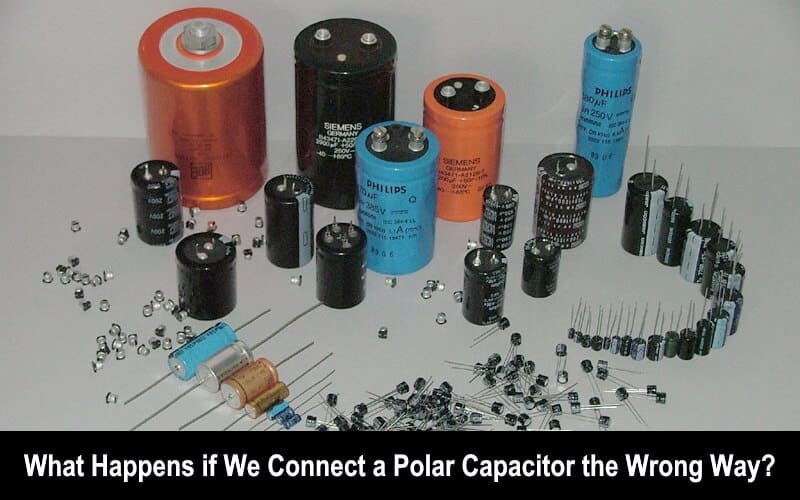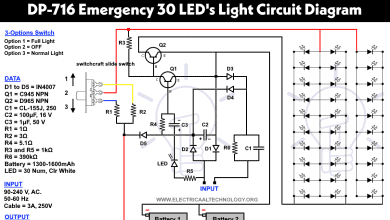What Happens if We Connect a Polar Capacitor the Wrong Way?
What Happens When You Connect an Electrolytic Polarized Capacitor in The Reverse Polarity?
There are different types of capacitors such as polar (fixed capacitors e.g. electrolytic, Pseudo-capacitors, ELDs, and super-capacitors) and non-polar capacitors (ceramic, mica, film, paper and variable capacitors). Capacitors play an active and important roles in both AC and DC circuits (i.e. filters, RC circuits, coupling & decoupling, power factor improvement, oscillators, snubber and motor starters etc). Let’s stick to the topic of polarized electrolytic capacitors.
An electrolytic polar capacitor is a type of polar capacitor which has polarity on its terminals denoted by cathode and anode (positive and negative terminals).
In an electrolytic capacitor, there is an insulating layer used as dielectric (solid, liquid or gas material) sandwiched between the two electrodes. There are two metal plates where the first plate as positive “”anode” is covered with the insulating oxide layer through anodization and electrolyte is used as the second terminal known as “Cathode”. There are three types of electrolytic capacitors viz aluminum, tantalum and niobium capacitors.
In aluminium electrolytic capacitors, electrodes are made up of pure aluminum however, the anode (positive) electrode is made by forming an insulating layer of aluminum oxide (Al2O3) through anodization. The electrolyte (solid or non-solid) is placed on the insulating surface of the anode. This electrolyte technically acts as the cathode. The second aluminum electrode is placed on top of electrolyte which acts as its electrical connection to the negative terminal of the capacitor.
The aluminum foils with paper in-between are wound together. They are impregnated in the electrolyte and then covered in a casing of aluminum. That’s enough briefing, let’s focus on the topic right now.
- Related Post: Difference Between a Battery and a Capacitor
What Happens to the Capacitor If Connected to the Reverse Voltage?
We know that a capacitor blocks DC and let’s pass the AC. A polar i.e. electrolytic capacitor must be connected to the right terminals of DC power supply for proper operation when using in DC circuits. In other words, the positive and negative DC source should be connected to the positive and negative terminals of the capacitor respectively.
Accidents are real and they occur often due to intentionally or by chance. Now let’s see what happens if a polar or electrolyte capacitor connected to the reverse terminal of DC power supply i.e. Negative to positive and vice versa.
Polar Electrolytic Capacitor will Explode in Reverse Polarity
Let’s discuss the last scenario as first to be on the safe side as a first priority. In case of reverse connection, the capacitor will not work at all and if the applied voltage is higher than the value of capacitor rating, the larger leakage current will start to flow and heat up the capacitor which lead to damage the dielectric film (the aluminum layer is very thin and easy to be broken) as compared to the applied DC voltage) even explode the capacitor.
Care must be taken into account while connecting a polarized capacitor with DC power supply with proper terminals. Otherwise, the reverse voltage may damage the overall capacitor with a bang or pop in a very short time (few seconds). This may lead to serious injury or hazardous fire (Tantalum capacitors do it happily).
The aluminum layers in the electrolytic capacitor only bear the Forward DC Voltage (same as forward bias diode). The reverse DC voltage across the polar capacitor will lead to capacitor failure due to short circuit between its two terminals via dielectric material (same as reverse bias diode operating in the breakdown region). The phenomenon is known as valve effect.
Keep in mind that the electrolyte used in the foil and electrolytic capacitor may heal and reform the capacitor to its normal position if very low reverse voltage has passed in the capacitor. So if you have applied a reversed voltage on a polar capacitor and using for hobbies projects, You must test and check the capacitor before placing in the circuit or replace with new one in case of commercial and industrial usage.
- Related Post: Difference Between Capacitor and Supercapacitor
Polarized Capacitor will Blast with Reverse Voltage
In case of reverse voltage (negative source to positive terminal and vice versa) will blast the aluminum electrolytic capacitor due to the hydrogen ion theory. In this wrong wiring connection, there is positive voltage across the electrolytic cathode and the negative voltage appears across the oxide layer. In this situation, the hydrogen ions (H2) gathered in the oxide layer will pass through the dielectric medium between the two plates and reach to the metal layer where it converts into Hydrogen gas. The pressure created by Hydrogen gas is sufficient to break the capacitor and the case may break out with blast and vapour.
Resistivity of Electrolytic Capacitor Become Smaller When Terminals are Reversed
When the positive and negative terminals are reverse connected. Hydrogen will be generated without producing the oxide film which is must for the dielectric medium. For this reason, the resistivity of a reverse connected electrolytic capacitor is smaller as compared to the proper connection i.e. positive and negative source to the positive and negative terminals respectively. This whole process will fail and damage the overall capacitor.
- Related Post: What is the Role of Capacitor in a Ceiling Fan?
Polar Capacitor Acts as Short Circuit in Backward Installation
The dielectric medium used in between the two electrodes of electrolytic capacitor is unidirectional i.e. it will pass the current only and only in one direction, same like the PN Junction diode. In case of reverse connection, the dielectric medium will not act as a resistance or an insulation material. Hydrogen gas will be generated in a very few seconds and the capacitor will act as a short circuit for the DC source which leads to capacitor failure (with bulging top or overall wear and tear component).
- Related Post: Why an Inductor acts as a Short Circuit in DC Supply?
Good to Know:
- The Polarized and electrolytic capacitor won’t be connected to the AC supply (both forward and reverse connection) as they are specially designed to be operated only and only in DC circuits in the right way. If so, the capacitor will explode immediately. We will discuss the whole scenario in the next article.
- The Non-Polar Electrolytic Capacitor is actually two back to back connected electrolytic capacitors in series (same as back-to-back diodes or two batteries connected in series). These capacitors are used occasionally due to low reliability and efficiency, large amount of losses and low voltage withstand ability.
Related Post: Difference between AC and DC (Current & Voltage)
Caution:
Always check the positive and negative terminal of electrolytic and polar capacitors. The one with a “-” mark printed on it (negative or arrow stripe) or short leg is known as “Cathode” or negative terminal while the other with long leg is known as “Anode” or positive terminal.
The little dude as polarized capacitor is very dangerous and happily blows up and draws blood in case of changing and revering its terminals or more leakage or forward current and voltage other than the rated voltage. Please wear safety glasses and don’t touch any part(s) of the circuit while playing and designing the circuits using capacitors.
Related Posts:
- Why Does Transformer Not Work on DC Supply instead of AC?
- AC or DC – Which One is More Dangerous And Why ?
- Why Do Electronic Circuits Use DC Current instead of AC?
- What Happens if a Battery is Connected to the AC Supply?
- What Happens to the Battery with Reverse Polarity Wiring Connection
- Why Can’t We Store AC in Batteries instead of DC?









Note that these little dudes will quite happily blow up if you put too much current or voltage through it, or if you connect it the wrong way round (although that only applies to the electrolytic capacitor). They are more than capable of drawing blood, but your limbs are safe and it’s quite difficult to blow them up without trying, as long as you take care when designing your circuits.